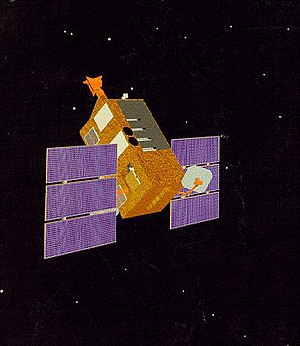Rossi X-ray Timing Explorer
 | |
| COSPAR ID | 1995-074A |
|---|---|
| SATCAT no. | 23757 |
| Website | RXTE home page |
| Start of mission | |
| Launch date | 30 December 1995 |
The Rossi X-ray Timing Explorer (RXTE) is a satellite that observes the time structure of astronomical X-ray sources. The RXTE has three instruments—the Proportional Counter Array, the High-Energy X-ray Timing Experiment (HEXTE), and one instrument called the All Sky Monitor. The RXTE observes X-rays from black holes, neutron stars, X-ray pulsars and x-ray bursts.
RXTE was launched from Cape Canaveral on 30 December 1995 on a Delta rocket, has an International Designator of 1995-074A and a mass of 3200 kg.
Observations from the Rossi X-ray Timing Explorer have been used as evidence for the existence of the frame-dragging effect predicted by the theory of general relativity. RXTE results have, as of late 2007, been used in more than 1400 scientific papers.
In January 2006 it was announced that Rossi had been used to locate a candidate intermediate-mass black hole named M82 X-1.[2]. In February 2006 data from RXTE was used to prove that the diffuse background X-ray glow in our galaxy comes from innumerable, previously undetected white dwarfs and from other stars' coronae.[3] In April 2008 RXTE data was used to infer the size of the smallest known black hole.[4]
Instruments
All-Sky Monitor (ASM)
The ASM consists of three wide-angle shadow cameras equipped with proportional counters with a total collecting area of 90 square cm. The instrumental properties are:[5]
- Energy range: 2 - 10 keV
- Time resolution: 80% of the sky every 90 minutes
- Spatial resolution: 3' x 15'
- Number of shadow cameras: 3, each with 6 x 90 degrees FOV
- Collecting area: 90 cm²
- Detector: Xenon proportional counter, position-sensitive
- Sensitivity: 30 mCrab
It was built by the CSR at MIT. The principal investigator was Dr. Alan M. Levine.
Proportional Counter Array (PCA)
The PCA is an array of five proportional counters with a total collecting area of 6500 square cm. The instrument was built by the EUD (formerly 'LHEA') at GSFC. The PCA principal investigator was Dr. Jean H. Swank.
The instrumental properties are:[6]
- Energy range: 2 - 60 keV
- Energy resolution: < 18% at 6 keV
- Time resolution: 1 microsec
- Spatial resolution: collimator with 1 degree FWHM
- Detectors: 5 proportional counters
- Collecting area: 6500 cm²
- Layers: 1 Propane veto; 3 Xenon, each split into two; 1 Xenon veto layer
- Sensitivity: 0.1 mCrab
- Background: 2 mCrab
The High Energy X-ray Timing Experiment (HEXTE)
The HEXTE consists of two clusters each containing four `phoswich scintillation detectors. Each cluster can "rock" (beamswitch) along mutually orthogonal directions to provide background measurements 1.5 or 3.0 degrees away from the source every 16 to 128 s. Automatic gain control is provided by using a 241Am radioactive source mounted in each detector's field of view. The HEXTE's basic properties are:[7]
- Energy range: 15 - 250 keV
- Energy resolution: 15% at 60 keV
- Time sampling: 8 microsecond
- Field of view: 1 degree FWHM
- Detectors: 2 clusters of 4 NaI/CsI scintillation counters
- Collecting area: 2 x 800 cm²
- Sensitivity: 1 Crab = 360 count/s per HEXTE cluster
- Background: 50 count/s per HEXTE cluster
The HEXTE was designed and built by the Center for Astrophysics & Space Sciences (CASS) at the University of California, San Diego. The HEXTE principal investigator was Dr. Richard E. Rothschild.
External links
References
- ^ http://heasarc.gsfc.nasa.gov/docs/xte/XTE.html
- ^ http://www.scienceblog.com/cms/dying_star_reveals_more_evidence_for_new_kind_of_black_hole_9685
- ^ "Galactic Glow Gleaned".
- ^ "NASA Scientists Identify Smallest Known Black Hole". 2008-04-01.
- ^ http://heasarc.gsfc.nasa.gov/docs/xte/ASM.html
- ^ http://heasarc.gsfc.nasa.gov/docs/xte/PCA.html
- ^ http://heasarc.gsfc.nasa.gov/docs/xte/HEXTE.html

